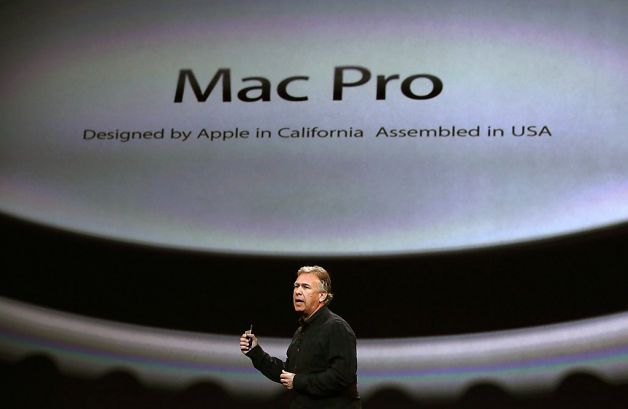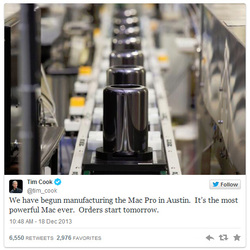Apple Kicks Off ‘Made in USA’ Push With Mac Pro
|
“We have begun manufacturing the Mac Pro in Austin,” Cook wrote in a posting yesterday on Twitter. “It’s the most powerful Mac ever.”
The cylindrical machine, which runs on Intel Corp.’s latest Xeon chip, will be available to order today at a starting price of $2,999, Apple said. While companies such as Google Inc. and Lenovo Group Ltd. are doing some final assembly in the U.S. of parts made overseas, Cook said in an interview in October that Apple is manufacturing — not just putting together — the Mac Pro’s metal parts in the U.S. “The difference with us is that we’re taking a bottoms-up approach,” Cook said at the time. “We don’t want to just assemble the Mac Pro here, we want to make the whole thing here. This is a big deal.” Apple’s partners are using industrial molds and production processes that were developed in the U.S., he said. |
High End
The newest version of the Mac Pro, a top-of-the-line computer used by graphic designers and filmmakers who require the fastest performance, is going on sale at the height of the holiday shopping season in customizable configurations starting at $2,999 and $3,999 depending on the chip’s power and amount of memory.
The sleek, rounded black machine, which looks like a space-age trash can or a small jet engine, is 9.9 inches tall and is an eighth the size of the current Mac Pro, the company said. Intel’s Xeon processors will let it handle some calculations at twice the speed of the existing model, Apple has said, and will use 70 percent less power because of its smaller size. The computer comes with 256 gigabytes of flash-based storage, expandable to one terabyte — the equivalent of 1,000 gigabytes.
Twenty States
Apple executive Phil Schiller said in October that more than 2,000 people in 20 states were working on the Mac Pro. The Cupertino, California-based company released a video of the highly automated processes used to build the machine, showing a puck-shaped plug of aluminum being stamped into the shape of the cylindrical shell, and then passed through a series of robots for polishing, anodizing and painting. Other machines insert electronic components onto circuit boards.
The last frames of the video show the words “Designed in Cupertino, Assembled in the USA” being etched on the bottom of the machine by laser. Under U.S. Federal Trade Commission regulations, companies can’t include the term “Assembled in USA” if that process only includes final piecing together of imported parts “in a simple ‘screwdriver’ operation in the U.S.”
So far, the company’s push isn’t poised to have a big impact. Of Apple’s $170.9 billion in annual revenue, more than 70 percent of that comes from the iPhone and iPad tablet, which are built in China. The new Mac Pro will probably contribute less than 1 percent of Apple’s sales in 2014, said Gene Munster, an analyst at Piper Jaffray Cos. He predicts the company will sell 1.1 million Mac Pros in 2014, compared with 300 million iPhones and iPads.
Google, Lenovo
Other large technology companies have also been doing more work in the U.S., yet few have begun manufacturing components in the country. Google, which makes the rival Android mobile operating system and Motorola smartphones, has been assembling its Moto X device at a Flextronics International Ltd. factory near Fort Worth, Texas, hiring more than 2,000 people. In June, Lenovo said it was adding 115 people to work on final assembly of PCs in Whitsett, North Carolina.
“We are designing, engineering and assembling Moto X in the USA,” Gabe Madway, a spokesman for Motorola, said in an e-mail. “Our parts come from all over but are assembled and in some cases made in the U.S.”
While Beijing-based Lenovo, the world’s largest PC maker, isn’t doing fabrication in the U.S., the automation equipment used at its Whitsett plant was made in the country and the company uses packing materials from local vendors, said Milanka Muecke, a spokeswoman.
Labor Conditions
Apple has faced stepped-up scrutiny of its overseas labor in recent years. Allegations of use of underage workers, forced overtime and other infractions have led the company to investigate conditions at China-based manufacturing partners Hon Hai Precision Industry Co. and Pegatron Corp. Apple has joined the Fair Labor Association, and publishes regular results of hundreds of factory audits in a Supplier Responsibility Report.
In December 2012, Cook told Bloomberg Businessweek that the company would spend $100 million to build a new version of one of its Mac models in the U.S. In testimony before the U.S. Senate in May, Cook said the Mac Pro would be assembled in Texas using parts made in Illinois and Florida and equipment made in Kentucky and Michigan. And last month, the company said a new Arizona plant will employ 2,000 people to produce a glass alternative made of synthetic sapphires that are increasingly being used in smartphones to cover camera lenses and home buttons.
Rebuilding Expertise
Cook declined to say how many total jobs Apple might create in the U.S. The biggest challenges have been getting more suppliers to set up shop, and re-establishing production-related expertise that has been disappearing since big technology companies started turning to foreign companies for manufacturing in the 1990s and 2000s, he said.
“We’re responsible for 2,000 jobs so far, and we’ll see how high that goes,” Cook said in the October interview. “The important thing is to re-develop the skills.”
Some of Apple’s suppliers are already taking steps to boost their operations in the U.S. Last month, Hon Hai said it would spend $30 million to build a factory in Harrisburg, Pennsylvania. Hon Hai CEO Terry Gou said the focus at that plant would be on developing automation technologies, not creating job-intensive production lines.
Given the lower labor costs and smooth supply chain Apple has built in Asia, the co
mpany
may never bring high-volume manufacturing of devices such as the iPhone back to the U.S., said Mike Fawkes, who oversaw Hewlett-Packard Co.’s supply-chain operations until 2008. While labor costs in China have been rising in recent years, they are still 60 percent lower than those in the U.S., according to Boston Consulting Group.
“It’s a positive sign to see Hon Hai further establish its U.S. presence,” said Fawkes. “That said, a $30 million factory is a drop in the bucket for manufacturing of any consequence.”




Leave a Reply
Want to join the discussion?Feel free to contribute!